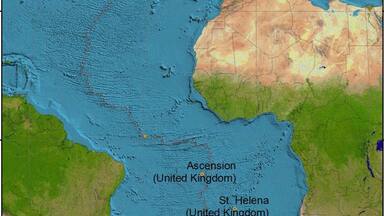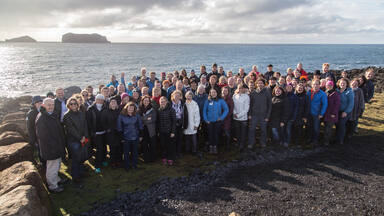Þingvellir National Park
Þingvellir National Park
Þingvellir (Thingvellir) is the National Park where the Althing, an open-air assembly representing the whole of Iceland, was established in 930 and continued to meet until 1798. Over two weeks a year, the assembly set laws - seen as a covenant between free men - and settled disputes. The Althing has deep historical and symbolic associations for the people of Iceland. The property includes the Þingvellir National Park and the remains of the Althing itself: fragments of around 50 booths built from turf and stone. Remains from the 10th century are thought to be buried underground. The site also includes remains of agricultural use from the 18th and 19th centuries. The park shows evidence of the way the landscape was husbanded over 1,000 years.
Description is available under license CC-BY-SA IGO 3.0
Parc national de Þingvellir
Þingvellir (Thingvellir) est le site en plein air de l'Althing, assemblée plénière représentant l'ensemble de l'Islande, qui s'est tenu à partir de 930 jusqu'en 1798. Durant une session annuelle qui durait une quinzaine de jours, l'assemblée élaborait des lois conçues comme des pactes entre hommes libres et réglait les différends. Pour la population islandaise, l'Althing est un lieu aux profondes résonances historiques et symboliques. L'ensemble comprend le Parc national du Þingvellir ainsi que les vestiges de l'Althing proprement dit, soit des fragments de quelque 50 cabanes de tourbe et de pierre. Il devrait subsister des vestiges du Xe siècle enfouis sous terre. Le site comprend également des vestiges de l'activité agricole au cours des XVIIIe et XIXe siècles. Le parc est un témoignage de l'aménagement du paysage sur près d'un millénaire.
Description is available under license CC-BY-SA IGO 3.0
المنتزه الوطني في ثينغفيلير
ثينغفيلير هي الموقع المكشوف (في الهواء الطلق) للـ"ألثينغ" – الجمعية العامة التي تمثل مجموع آيسلندا – التي انعقدت ابتداءً من العام 930 وحتى العام 1798. وخلال دورة سنوية كانت تمتد على مدى خمسة عشر يومًا، كانت الجمعية تصوغ قوانين – تعتمَد كمواثيق بين أشخاص أحرار – وتتولى تسوية النزاعات. بالنسبة إلى الشعب الإيسلندي، الألثينغ مكان فيه أصداء تاريخية ورمزية عميقة. وتشمل المجموعة المنتزه الوطني في ثينغفيلير وآثار ألثينغ بحدّ ذاتها، أي قطعًا من 50 كوخًا من الخُثّ والحجر. ولا بدّ أيضًا من وجود آثار من القرن العاشر مطمورة تحت الأرض. كما يشمل الموقع أيضًا آثارًا للنشاط الزراعي الذي كان قائمًا في القرنين الثامن عشر والتاسع عشر. والمنتزه شهادة على ترتيب المناظر طوال ألفية كاملة.
source: UNESCO/CPE
Description is available under license CC-BY-SA IGO 3.0
平位利尔国家公园
平位利尔(丁威勒)国家公园是一个曾经在冰岛历史上很受关注的会议——阿尔廷(露天议会)的召开地。阿尔廷始于公元930年,并一直持续到公元1798年。每年, 在两周多的时间内,阿尔廷制订相关的法律,强调自由民主的理念,并解决争议。对于冰岛人民来说,阿尔廷具有深远的历史渊源和象征作用。遗址包括平位利尔国家公园和阿尔廷会址,即大约50个用草皮和石头建造的摊棚的碎片。10世纪时的废墟被认为已深埋地下。该遗址还有18世纪和19世纪遗留下来的农用工具。该公园展示了一千多年间景观的保护方式。
source: UNESCO/CPE
Description is available under license CC-BY-SA IGO 3.0
Национальный парк Тингвеллир
Тингвеллир – это национальный парк на месте, где в 930 г. был основан и до 1798 г. продолжал собираться Альтинг – национальное собрание под открытым небом. В течение примерно двух недель в году собрание принимало законы, представлявшие собой соглашения между свободными людьми, и решало споры. Альтинг имеет огромное историческое и символическое значение для народа Исландии. Размещенный в районе активной вулканической деятельности, объект включает национальный парк Тингвеллир и остатки самого Альтинга: фрагменты примерно 50 укрытий, сооруженных из камня и торфа.
source: UNESCO/CPE
Description is available under license CC-BY-SA IGO 3.0
Parque Nacional de Þingvellir
En Þingvellir (Thingvellir) se congregó por primera vez en el año 930 la asamblea denominada Althing, que representaba a todos los habitantes de Islandia. Este órgano legislativo y judicial siguió reuniéndose al aire libre durante dos semanas por año hasta 1798, zanjando litigios y promulgando leyes que se consideraban pactos establecidos entre hombres libres. El Althing tiene, por consiguiente, un hondo significado histórico y simbólico para el pueblo islandés. El sitio comprende el Parque Nacional de Thingvellir y los vestigios del Althing, formados por restos de cincuenta chozas construidas con turba y piedras. Se cree que también hay enterrados vestigios arqueológicos del siglo X. El sitio posee además huellas de actividades agrícolas que datan de los siglos XVIII y XIX. En el parque también se puede apreciar cómo los seres humanos configuraron el paisaje durante más de un milenio.
source: UNESCO/CPE
Description is available under license CC-BY-SA IGO 3.0
シングヴェトリル国立公園
source: NFUAJ
Nationaal park Þingvellir (Thingvellir)
Source: unesco.nl
Outstanding Universal Value
Brief synthesis
A rift valley with its high cliffs makes Þingvellir National Park a magnificent natural backdrop for the open air parliamentary assembly (or Alþing) of Iceland, which was held there annually from around 930 AD to 1798. Over two weeks a year, the assembly set laws – seen as a covenant between free people – and settled disputes. The Alþing has deep historical and symbolic associations for the people of Iceland. The property includes the Þingvellir National Park and the remains of the Alþing itself: fragments of around 50 booths built from turf and stone. Remains from the 10th century are thought to be buried underground. The property also includes Þingvellir Church and adjacent farm, the population of arctic char in Lake Þingvallavatn as well as remains of agricultural use from the 18th and 19th centuries. Its dramatic history dating back to the establishment of the Alþing gives insight into how a Viking Age pioneer community organized its society from scratch and evolved towards the modern world.
Þingvellir National Park is located in an active volcanic area, just 49 km east of Reykjavík, the capital of Iceland, and covers 24,000 ha, of which 9,270 ha constitute the World Heritage property. Its best-defined feature is a major rift, which has produced dramatic fissures and cliffs demonstrating inter-continental drifting in a spectacular and understandable way. The National Park is enclosed by a varied belt of mountains on three sides, featuring grass-covered lava fields, and Lake Þingvallavatn lies at its southern end. This outstanding scenery gives the area its unparalleled value.
The World Heritage property contains the physical remains of the Alþing and its long persistence at Þingvellir. There is a well-known kinship between the Alþing, Þingvellir, and Germanic Law and governance, documented through the Icelandic sagas and the written codification of the Grágás Laws. This closeness was strengthened in the 19th century by the independence movement and a growing appreciation of landscape values and their perceived association with ‘natural’ and ‘noble’ laws. Furthermore, the Alþing is closely linked to its hinterland (now the landscape of the National Park), an agricultural land that was traditionally used as grazing grounds for those attending the Alþing, and across which the tracks led to the Assembly grounds. The fossilised cultural landscape of the park reflects the evolution of the farming landscape over the past thousand years, with its abandoned farms, fields, tracks; associations with people and events recorded in place names and archival evidence also document the settlement in Iceland as well as the high natural values of this landscape. The inspirational qualities of Þingvellir’s landscape, derived from its unchanged dramatic beauty, its association with national events and ancient systems of law and governance, have lent the area its iconic status and turned it into the spiritual centre of Iceland.
Criterion (iii): The Alþing and its hinterland, the Þingvellir National Park, represent, through the remains of the assembly ground, the booths for those who attended, and through landscape evidence of settlement extending back possibly to the time the assembly was established, a unique reflection of medieval Norse/Germanic culture and one that persisted in essence from its foundation in 930 AD until the 18th century.
Criterion (vi): Pride in the strong association of the Alþing to medieval Norse/Germanic governance, known through the 12th century Icelandic sagas and reinforced during the fight for independence in the 19th century, have, together with the powerful natural setting of the assembly grounds, given the site iconic status as a shrine for the national Icelandic identity.
Integrity
The World Heritage property has all the necessary attributes to express the Outstanding Universal Value of the Alþing and its surrounding landscape, and the assembly area and its setting in the unspoiled landscape are protected. Located in an active seismic zone, the land is subject to natural change. The floor of the valley has subsided by some 3-4 metres since the Alþing was founded at Þingvellir and will continue to do so. In 2004, the National Park was enlarged by legislative Act no. 47/2004 and the enlarged protection area surrounds the World Heritage property, and provides protection equivalent to a buffer zone.
Authenticity
The overall cultural landscape has changed little since the 10th century, and more recent buildings such as the Þingvellir Church and Farm respect traditional styles. The property lacked authenticity in two specific aspects at the time of inscription: summer houses and conifer trees. Contemporary “summer houses” are particularly intrusive along the western shores of Lake Þingvallavatn, southwest of the innermost assembly site, and a few can also be found in the wider landscape to the east of the assembly site, and can affect the inspirational and spiritual values of the property. The conifer trees in the innermost assembly site have since then been cut down. At the time of inscription, the hotel Valholl was located in the inner core of the nominated area, yet it burnt down in 2009.
Protection and management requirements
Þingvellir National Park has remained under the same administration arrangement (the Þingvellir Commission) since it was founded in 1930. Thus, the supervisory duties of the National Park administration and its responsibility for conditions in the Park and its impact area are very strong. The Park administration pursues all possibilities to ensure that the National Park does not deteriorate and that it is run in a sustainable fashion.
Four permanent staff work for the Þingvellir National Park on a year-round basis. The Director is in charge of its day-to-day operation, finances and the staff, an interpretive manager, head warden and a secretary. From 1 April to 1 November, 10-12 seasonal rangers work in the park. They are responsible for supervision, interpretive services and minor maintenance work, along with other permanent employees. Experts on conservation and preservation of archaeological monuments and sites are consulted via the Archaeological Heritage Agency of Iceland.
The Þingvellir Commission schedules regular revisions of the Management Plan. Its main objectives are to safeguard the natural historical area and heritage sites of the National Park for the future, while also making preparations for visitors, whose numbers may be expected to rise steadily. As seismic activities are a natural phenomenon in the area, any threats from such occurrences will be dealt with appropriately as they occur.
The 2004 ICOMOS evaluation made 6 recommendations with respect to Þingvellir´s inscription on the World Heritage List, dealing with archaeological research, holiday houses, forestry and infrastructure (roads, bridges and car parks). Those recommendations, and any subsequent recommendations made by the World Heritage Committee and its Advisory Bodies, are met with ad-hoc projects or are addressed in revisions of the management plan.



